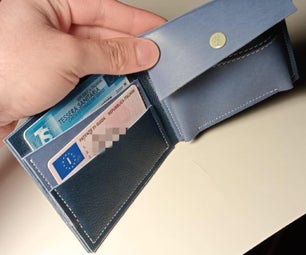Introduction: Wall Mounted Monster Hand With Talons
Spooky and a great conversation starter. I have two normal looking mannequin hands mounted in my house, but I wanted something more gore, so here we are- gross monster hand. Looks amazing, can hold you keys, small fruits and soap. Not terribly useful, but oh so fabulous.
This project is totally customisable. Instead of gray, use green paint for a witch hand. Use red paint to splatter fake blood for Halloween. I have one hand in the bathroom and I use its fingers to collect my hair bands. Another one is by the entrance door, holding my umbrella. I also made one hand for a friend who runs a B&B and it had an NFC tag in the palm, so guests had to touch their phones to the hand in order to get a WiFi password.
If you are missing a few supplies, don't fret, you can always improvise. Instead of modelling epoxy putty, use plasticine and use a disposable brush to cover it with a layer of regular epoxy (gorilla two part epoxy) to harden it. You can get Styrofoam hands in some craft stores, so use that if you can't find a mannequin hand. If you don't have dry pigments, use old make up (eyeshadows and eyebrow powders) but remember to seal it with a good coat of varnish, so it doesn't smudge.
Supplies
Mannequin hand
Sanding paper, craft knife, nail file, scissors
Epoxy glue, epoxy resin, super glue, disposable
Modelling putty, spray filler, modelling tools
False press on nails (long and pointy)
PVA glue (for paper mache) and tissue paper
Acrylic paints, selection of brushes and sponges, spray varnish
3D printer, 50mm screw
Step 1: First Sanding and Scrubbing
My mannequin hand was used, but in a good condition, not too many chips, no parts falling away. For a used, kept in the yard mannequin hand, I scored a jackpot.
I began by sanding over the chips with a 60 and 80 grit sandpaper.
I paid special attention to fingernail area, I sanded all the way through to the bottom layer. It will be easier to glue fake nails later.
Once that was done, I scrubbed it with a hand brush, soap and wire brush in stubborn areas.
Picture 1-3
Dirty plastic, visible chips
Picture 5&6
After sanding and thorough washing with soap
Step 2: False Nails
I played around with a bunch of fake nails to figure which size went with which finger. Once that was established I used clippers and a nail file to modify the nail and shape the tips.
I used super glue to glue them to the nail beds. Make sure to glue them straight. Once dry, I flipped the hand over and applied a few drops of epoxy behind the finger nails. It will secure the nails further.
NOTE: I didn’t have proper press on nails at home, I had the type that are used for extensions and have to be used with gel or acrylic. I don’t recommend using them, it took me a long time to get them smooth and filled out with epoxy. I recommend you get regular press on nails, something like this product https://www.amazon.co.uk/600Pcs-Artificial-Stilett...
Step 3: Talons
Next step is to create talons. You could leave those nails as they are, but I wanted them to be really thick and gross.
I used epoxy putty for modelling, it’s mixed 1:1 and is a bit like plasticine, but stickier. Dries within 2 hours, so you have some time to play around with it. I mixed a small amount of putty and filled the finger nails. You can use your fingers to do it or whatever tool you have at hand, I used fondant modelling tools. Let that dry for 2 hours and then mix more putty and apply some more to the talons. We want them really thick. Epoxy putty can be sculpted and sanded once it’s dry, so whatever mistake you make, don’t worry, you will be able to sand it later.
Step 4: Adding Tendons and Veins
I wanted really visible, thick tendons. In the end I free-handed it to the point that I wasn’t sure if I was sculpting veins, scars or tendons. It looked creepy in the end, so either way-it worked. I sculpted it with fingers, fondant tools, let it dry and scraped thicker parts with a craft knife and sandpaper.
Step 5: Layer of Resin
I was a bit concerned my epoxy putty won’t adhere to the plastic properly, so I strengthened it by brushing a layer of resin over the veins.
When it came to nails, I used thick resin to fill in the nail bed and create a smooth surface (YOU WON’T HAVE TO DO IT IF YOU GET PORPER PRESS ON NAILS).
Step 6: Spray Filler, More Sanding
I sprayed it generously with a spray filler. Don’t worry too much about being messy, majority of that filler will be sanded anyway.
Take a look at the fingernails, give them a light sanding (preferably with an actual nail file). If you are not sure if they are smooth enough, paint them with a thin coat of watered down paint- ridges and rough patches will become visible once coated in paint- and sand again until you are satisfied.
Step 7: Paper Mache
Paper mache projects always require you to make them as smooth as possible, wrinkle free, bubble free etc. Not this project though! We want wrinkles, texture and bubbles. Do your absolute worse. Cover the surface with glue, place a large sheet of tissue paper over the glue and apply more glue to the top. Add more bits of tissue to create more wrinkles.
TIP: Have a picture of wrinkled hands printed out to check how wrinkles are distributed.
Step 8: Knuckle Texture and 1st Paint Layer
I applied two coats of thick acrylic paint to the knuckle areas. I will scrape some of this paint later to make the knuckles look a little bit rough and to add some texture (see step 10).
Once that's done, apply first coat of paint. Use a brush, dab and swipe to get the paint everywhere and especially cover the wrinkles and green tissue paper. This paint colour will be the lightest. I painted two layers of this base colour to make sure everything was covered.
Step 9: More Paint
Third paint layer was darker than the first two and applied with an old make-up sponge (regular sponge will do too). Just dab that darker colour to create some depth.
I used watered down black paint, small brush and sponge to apply shadows to the big veins/tendons.
Step 10: Nails and Knuckles
Use one coat of black acrylic paint to colour the nails.
Pic 2
Knuckles covered in paint
Pic 3
Knuckles scraped with a knife to create more texture. I dabbed some more paint over them (see next step)
Step 11: Dry Brushing Technique, Pigments, Make Up
Using a dry brush technique and powdered pigments (or small amount of paint) I added some more colour. Black, red and grey mainly. I actually couldn’t find a black pigment, so I used black eyebrow powder. Eyeshadow would work to, as long as not too glittery.
Not everyone has a set of multiple acrylic paints, pigments and god knows what else. So...experiment with what you have at hand.
LAST STEP- varnish! Spray on varnish will work best, especially if you used powdered pigments. They will smudge if you use a brush-on varnish. I used matt spray.
Step 12: Wall Mount
The minute I got a 3D printer, I stopped thinking like a regular human being. If I need something, my first thought is- can I print it? I removed the original plug and printed this screw-holder-thingy. Filled the yellow plug with epoxy, put the screw inside and attached it to the hand. If you have a plug already installed in the wall all you have to do it twist the hand around and voila!
Step 13: Possible Use

Runner Up in the
Paint Challenge















4 Comments
2 years ago
“Once that was done, I scrubbed it with a hand brush” - classic!
2 years ago
Amazing idea and making it really wonderful!!! Well-done!!
2 years ago
Great project! Thank you for sharing your process. Could you please give the link for where you purchased your mannequin hands? Thank you for taking the time to answer.
2 years ago
Nice Work...When i see the front photo i think it is nearly 6 feet....